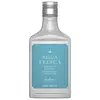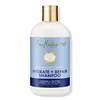What's inside
What's inside
 Key Ingredients
Key Ingredients

No key ingredients
 Benefits
Benefits

 Concerns
Concerns

 Ingredients Side-by-side
Ingredients Side-by-side

Water
Skin ConditioningSodium Cocoyl Isethionate
CleansingSodium Lauroyl Methyl Isethionate
CleansingGlycerin
HumectantSodium Lauroyl Lactylate
EmulsifyingDecyl Glucoside
CleansingAcrylates Crosspolymer-4
Emulsion StabilisingDisteareth-75 Ipdi
Artocarpus Heterophyllus Fruit Extract
Skin ConditioningHydrolyzed Vegetable Protein
Skin ConditioningHydrolyzed Pea Protein
EmollientOpuntia Ficus-Indica Seed Oil
EmollientLactobacillus Ferment
Skin ConditioningSodium PCA
HumectantMaltol
MaskingPolyquaternium-80
CleansingPhospholipids
Skin ConditioningPolyquaternium-16
Lactic Acid
BufferingUrea
BufferingGlycine
BufferingNiacinamide
SmoothingAllantoin
Skin ConditioningAlanine
MaskingSerine
MaskingSodium Hyaluronate
HumectantTocopheryl Acetate
AntioxidantPotassium Hydroxide
BufferingGlycol Distearate
EmollientAloe Barbadensis Leaf Juice
Skin ConditioningSqualane
EmollientAmaranthus Caudatus Seed Extract
Skin ConditioningMauritia Flexuosa Fruit Oil
Skin ConditioningHelianthus Annuus Seed Oil
EmollientPanthenol
Skin ConditioningGuar Hydroxypropyltrimonium Chloride
Skin ConditioningRosmarinus Officinalis Leaf Extract
AntimicrobialDiisostearyl Malate
EmollientTocopherol
AntioxidantCitric Acid
BufferingTrisodium Ethylenediamine Disuccinate
Sodium Phytate
Potassium Sorbate
PreservativeSodium Benzoate
MaskingPhenoxyethanol
PreservativeParfum
MaskingWater, Sodium Cocoyl Isethionate, Sodium Lauroyl Methyl Isethionate, Glycerin, Sodium Lauroyl Lactylate, Decyl Glucoside, Acrylates Crosspolymer-4, Disteareth-75 Ipdi, Artocarpus Heterophyllus Fruit Extract, Hydrolyzed Vegetable Protein, Hydrolyzed Pea Protein, Opuntia Ficus-Indica Seed Oil, Lactobacillus Ferment, Sodium PCA, Maltol, Polyquaternium-80, Phospholipids, Polyquaternium-16, Lactic Acid, Urea, Glycine, Niacinamide, Allantoin, Alanine, Serine, Sodium Hyaluronate, Tocopheryl Acetate, Potassium Hydroxide, Glycol Distearate, Aloe Barbadensis Leaf Juice, Squalane, Amaranthus Caudatus Seed Extract, Mauritia Flexuosa Fruit Oil, Helianthus Annuus Seed Oil, Panthenol, Guar Hydroxypropyltrimonium Chloride, Rosmarinus Officinalis Leaf Extract, Diisostearyl Malate, Tocopherol, Citric Acid, Trisodium Ethylenediamine Disuccinate, Sodium Phytate, Potassium Sorbate, Sodium Benzoate, Phenoxyethanol, Parfum
Water
Skin ConditioningSodium Lauroyl Methyl Isethionate
CleansingCocamidopropyl Betaine
CleansingSodium Methyl Cocoyl Taurate
CleansingSodium Cocoyl Isethionate
CleansingGlycol Distearate
EmollientGlycerin
HumectantButyrospermum Parkii Butter
Skin ConditioningHoney
HumectantYogurt Powder
Yogurt Extract
Skin ConditioningInulin
Skin ConditioningAdansonia Digitata Seed Oil
EmollientTrichilia Emetica Seed Oil PEG-8 Esters
EmollientCocos Nucifera Oil
MaskingPanthenol
Skin ConditioningGuar Hydroxypropyltrimonium Chloride
Skin ConditioningTriethyl Citrate
MaskingCaprylyl Glycol
EmollientBenzoic Acid
MaskingMica
Cosmetic ColorantTitanium Dioxide
Cosmetic ColorantSodium Benzoate
MaskingParfum
MaskingWater, Sodium Lauroyl Methyl Isethionate, Cocamidopropyl Betaine, Sodium Methyl Cocoyl Taurate, Sodium Cocoyl Isethionate, Glycol Distearate, Glycerin, Butyrospermum Parkii Butter, Honey, Yogurt Powder, Yogurt Extract, Inulin, Adansonia Digitata Seed Oil, Trichilia Emetica Seed Oil PEG-8 Esters, Cocos Nucifera Oil, Panthenol, Guar Hydroxypropyltrimonium Chloride, Triethyl Citrate, Caprylyl Glycol, Benzoic Acid, Mica, Titanium Dioxide, Sodium Benzoate, Parfum
Ingredients Explained
These ingredients are found in both products.
Ingredients higher up in an ingredient list are typically present in a larger amount.
Glycerin is already naturally found in your skin. It helps moisturize and protect your skin.
A study from 2016 found glycerin to be more effective as a humectant than AHAs and hyaluronic acid.
As a humectant, it helps the skin stay hydrated by pulling moisture to your skin. The low molecular weight of glycerin allows it to pull moisture into the deeper layers of your skin.
Hydrated skin improves your skin barrier; Your skin barrier helps protect against irritants and bacteria.
Glycerin has also been found to have antimicrobial and antiviral properties. Due to these properties, glycerin is often used in wound and burn treatments.
In cosmetics, glycerin is usually derived from plants such as soybean or palm. However, it can also be sourced from animals, such as tallow or animal fat.
This ingredient is organic, colorless, odorless, and non-toxic.
Glycerin is the name for this ingredient in American English. British English uses Glycerol/Glycerine.
Learn more about GlycerinGlycol Distearate serves as a pearlizing or opacifying agent in cosmetic products.
It's often included in cleansers and haircare products to give them a lustrous or shimmering appearance.
It is derived from stearic acid, a natural fatty acid commonly found in vegetable oils and animal fats.
Glycol Distearate isn't fungal acne safe.
Learn more about Glycol DistearateThis ingredient is derived from guar gum.
It is a conditioning ingredient, meaning it helps soften skin and hair.
Panthenol is a common ingredient that helps hydrate and soothe the skin. It is found naturally in our skin and hair.
There are two forms of panthenol: D and L.
D-panthenol is also known as dexpanthenol. Most cosmetics use dexpanthenol or a mixture of D and L-panthenol.
Panthenol is famous due to its ability to go deeper into the skin's layers. Using this ingredient has numerous pros (and no cons):
Like hyaluronic acid, panthenol is a humectant. Humectants are able to bind and hold large amounts of water to keep skin hydrated.
This ingredient works well for wound healing. It works by increasing tissue in the wound and helps close open wounds.
Once oxidized, panthenol converts to pantothenic acid. Panthothenic acid is found in all living cells.
This ingredient is also referred to as pro-vitamin B5.
Learn more about PanthenolParfum is a catch-all term for an ingredient or more that is used to give a scent to products.
Also called "fragrance", this ingredient can be a blend of hundreds of chemicals or plant oils. This means every product with "fragrance" or "parfum" in the ingredients list is a different mixture.
For instance, Habanolide is a proprietary trade name for a specific aroma chemical. When used as a fragrance ingredient in cosmetics, most aroma chemicals fall under the broad labeling category of “FRAGRANCE” or “PARFUM” according to EU and US regulations.
The term 'parfum' or 'fragrance' is not regulated in many countries. In many cases, it is up to the brand to define this term.
For instance, many brands choose to label themselves as "fragrance-free" because they are not using synthetic fragrances. However, their products may still contain ingredients such as essential oils that are considered a fragrance by INCI standards.
One example is Calendula flower extract. Calendula is an essential oil that still imparts a scent or 'fragrance'.
Depending on the blend, the ingredients in the mixture can cause allergies and sensitivities on the skin. Some ingredients that are known EU allergens include linalool and citronellol.
Parfum can also be used to mask or cover an unpleasant scent.
The bottom line is: not all fragrances/parfum/ingredients are created equally. If you are worried about fragrances, we recommend taking a closer look at an ingredient. And of course, we always recommend speaking with a professional.
Learn more about ParfumSodium Benzoate is a preservative. It's used in both cosmetic and food products to inhibit the growth of mold and bacteria. It is typically produced synthetically.
Both the US FDA and EU Health Committee have approved the use of sodium benzoate. In the US, levels of 0.1% (of the total product) are allowed.
Sodium benzoate works as a preservative by inhibiting the growth of bacteria inside of cells. It prevents the cell from fermenting a type of sugar using an enzyme called phosphofructokinase.
It is the salt of benzoic acid. Foods containing sodium benzoate include soda, salad dressings, condiments, fruit juices, wines, and snack foods.
Studies for using ascorbic acid and sodium benzoate in cosmetics are lacking, especially in skincare routines with multiple steps.
We always recommend speaking with a professional, such as a dermatologist, if you have any concerns.
Learn more about Sodium BenzoateSodium cocoyl isethionate is a natural ingredient from coconut oil. It is an ultra gentle cleanser that gives a nice foam without drying the skin or impacting the skin barrier.
The amount of foam created depends on the amount of sodium cocoyl isethionate used in the product.
This ingredient also helps improve the spreadability of a product.
Learn more about Sodium Cocoyl IsethionateSodium Lauroyl Methyl Isethionate is a cleansing ingredient. It is a surfactant, meaning it helps gather dirt, oil, and other pollutants. This helps them be rinsed away easily.
Water. It's the most common cosmetic ingredient of all. You'll usually see it at the top of ingredient lists, meaning that it makes up the largest part of the product.
So why is it so popular? Water most often acts as a solvent - this means that it helps dissolve other ingredients into the formulation.
You'll also recognize water as that liquid we all need to stay alive. If you see this, drink a glass of water. Stay hydrated!
Learn more about Water